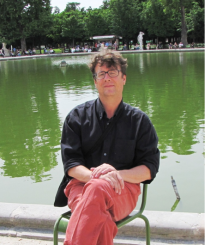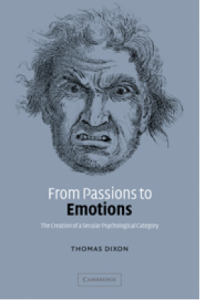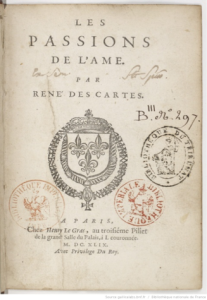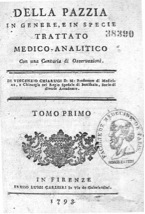Louis C. Charland is Professor in the Department of Philosophy, the Department of Psychiatry, the School of Health Studies, as well as member of the Rotman Institute of Philosophy, at the University of Western Ontario in London, Ontario, Canada. Professor Charland has published widely on the history and philosophy of psychiatry and the  theoretical foundations of the affective sciences. Professor Charland is currently International Partner Investigator with the Australian Research Council Centre of Excellence on the History of Emotion in Perth, Australia, and affiliated research scholar with the Centre for History of the Emotions, at Queen Mary University of London. Dr. Charland is also author and co-author of several public policy reports concerned with research ethics, mental health, and program evaluation.
theoretical foundations of the affective sciences. Professor Charland is currently International Partner Investigator with the Australian Research Council Centre of Excellence on the History of Emotion in Perth, Australia, and affiliated research scholar with the Centre for History of the Emotions, at Queen Mary University of London. Dr. Charland is also author and co-author of several public policy reports concerned with research ethics, mental health, and program evaluation.
This post originally appeared on the blog of the Australian Research Council Centre of Excellence for the History of Emotions (Europe 1100-1800). You can read the original posting here.
In this blog post, I briefly share some results of research undertaken in my role as Partner Investigator with the Australian Research Council Centre of Excellence for the History of Emotions, based at The University of Western Australia in Perth, Australia. In honor of National Science Week in Australia, I argue that science needs “passion” and that for this we must turn to the history of emotions.
The term and concept “passion” no longer figures in contemporary scientific efforts to understand emotion or other related phenomena in the affective domain. “Emotion” now is the keyword and paradigm theoretical posit of the affective sciences, although “feeling,” “mood,” and “affect” also play a significant role. The verdict appears to be that “passion” is now a matter of historical interest only, and can otherwise be ignored, although admittedly, the term is sometimes still employed in everyday discourse and some academic research, to refer to very intense and powerful emotional states. Note that even the history of “passion” now falls under the rubric of “emotion.” For example, this blog entry is meant to be a contribution to the dissemination efforts of the Australian Research Council Centre for Excellence for the History of Emotions. Again, the keyword here is “emotion,” even though the topic is “passion.”
In general, situating the historical study of “passion” under the general rubric of “emotion” does not pose major problems. In many cases, older usages of the term “passion” can, with appropriate provisions, even be rendered using the term “emotion,” a common practice. However, there is at least one particular context where this practice proves to be misleading. This is the case where both the terms “passion” and “emotion” and their associated concepts are intended as distinct, but mutually complementary, posits in an overall theory of the affective domain. There are in fact several pivotal milestones in the history of affective terms and concepts where this occurs. In such cases, rendering the term “passion” as “emotion” is misleading. The reason is that it obscures an important lexical and conceptual distinction in the original texts under study. Yet, there are cases where “passion” has been uncritically rendered as “emotion” in the study of such texts. As a result, the importance of the distinction is lost on readers, especially when the original texts are not present or easily available. This makes it appear as if we can dispense with “passion” in the translation and interpretation of such texts – as if “emotion” can do all the work that “passion” used to do. But this is not so.
The primary thesis of this short essay is that this relegation of “passion” to the proverbial ‘dustbin’ of history represents an important loss, not only for the history of “emotion,” but also for contemporary science; in particular, scientific efforts to explain the nature of “emotion” and other related phenomena in the affective domain. In particular, this omission leaves us without adequate conceptual resources to properly describe and explain the nature and organization of long term affective states and processes. We must therefore reinstate “passion” into science. No doubt, this is a call for reform on a grand scale. It is also a telling lesson on the importance of historical studies for present day science, philosophy, and even public life and our common sense understanding of “emotion”.
All of this, of course, requires stipulating an appropriate sense of “passion,” which admittedly is a term with a long and variegated history of conceptual change. As we shall see, though it is certainly complex, the history of “passion” and its relation to “emotion” is still vibrant and full of promise for those who wish to study it. This is no ‘dustbin.’ On the contrary, it is an historical domain with important lessons for how we should understand the function and limitations of our current term “emotion.”
In the sense intended here, “passions” are complex long term affective states and processes that differ from “emotions,” which are affective states and processes of shorter duration and lesser complexity. Moreover, properly understood, passions often serve to organize emotions and so must therefore be carefully distinguished from these. So, for example, think of jealousy over time, perhaps months or years. The jealous individual in the throes of such a passion will respond with very specific emotions – suspicion, anger, rage, and revenge, or maybe forgiveness – during the course of that passion. They will also experience very specific associated feelings – despair, resentment, and maybe, we hope, eventually relief. Eliminate the passion, and you eliminate the specific, rule-governed, course of emotional dispositions and responses that typically accompany and issue from that passion. In contrast, an individual who is not in the throes of such a passion will not respond, or be disposed to respond, in the same way as the person who is.

Now for some history. Before we go any further, it is important to be reminded of the fact – and it is an historical fact – that the term “emotion” is a relatively recent arrival on the contemporary philosophical and scientific stage. Prior to the arrival of “emotion,” “passion” and its various lexical cognates in various languages was the primary term of art in matters that concerned the affective domain. Since its emergence, both the denotation and connotations of the term “emotion” have changed dramatically, although the term itself, as a lexical item, has remained mostly the same. In the 16th and 17th centuries, it was common to refer to ‘emotions of the pulse’, or ‘emotions of the clouds’, a physical usage that has changed as the term has acquired more psychological connotations. Historian Thomas Dixon gives a wonderful, very comprehensive account of these developments from “passion” to “emotion” in his classic work, ‘From Passion to Emotion: The Creation of a Secular Category’. The bulk of Dixon’s discussion focusses on this transition in English texts, but it also occurs – to some degree, sometimes rather differently – in French, Spanish, Italian, and German texts of the same period.
A key figure whose influence is notable across much of this history is the French philosopher-scientist, Rene Descartes (1596-1650). He argued that it would be better (mieux) for science if we started referring to ‘emotions’ of the soul, rather than ‘passions’ of the soul.
Yet, at the same time, in keeping with tradition, Descartes decided to title his 1649 book on the topic ‘The Passions of the Soul’ (Les Passions de L’ame).

Descartes wrote in French, which like Spanish and Italian, has easily recognizable lexical equivalents for the English words “passion” and “emotion.” His suggestion that it would ultimately be better for us to speak of “emotion” rather than “passion” in scientific efforts to understand the affective domain, is tantamount to a conceptual revolution. He introduced a new, emerging, psychological meaning of the term “emotion” to the scientific world, setting in motion a larger transition in which “emotion” eventually came to replace “passion” as the keyword of the affective sciences. In doing so, he also refocused the scientific study of affective states and processes on episodes of relatively short duration, in keeping with the methodological orientation of current inquiries into the heart and nervous system. It was hard to find a place for affective states and processes of long duration in this new explanatory paradigm that focussed on direct observation and measurement in the here and now. That had been an important characteristic of the older passions, from which a person could suffer chronically for months, or even years. The new emotions were more sudden, transient, motions of the soul, now ‘active’ determinants of action and behavior that moved individuals to act. This made them quite different from the more ‘passive’ passions of the soul of ancient times, which the soul was said to suffer (Gr. pathé).

Another, later, medical writer who also used both the terms “passion” and “emotion” is the Florentine medical doctor, Vincenzo Chiarugi (1759-1829). His views on “passion” and “emotion” are contained in his 1793-5 classic work on insanity, Della Pazzia. He referred to these concepts in his native Italian, as “passioni” and “emozioni.”
Crucially, unlike Descartes, who argued that ultimately it would be better (mieux) to use the term “émotion” instead of “passion,” Chiarugi forcefully demonstrated that we must retain and use both terms, because they serve different purposes.
Chiarugi therefore apparently disagrees with Descartes on the relationship between “passion” and “emotion.” While the French scientist suggests that we can replace “passion” with “emotion,” the Italian doctor asserts that we need both, which means that we cannot replace the former with the latter, as Descartes had suggested.
Chiarugi’s work constitutes an important example of our thesis that “passion” and “emotion” are distinct, but mutually complementary, theoretical terms and concepts in the affective sciences. Other, different versions of the distinction, and the reasons for making it, can be found in the work of medical writers like Philippe Pinel (1745-1826), Sir Alexander Crichton (1763-1856), Jean-Étienne Dominique Esquirol (1772-1840), as well as the philosopher Immanuel Kant (1724-1804). What is curious about all this is that, although they are all major figure in their respective fields, this aspect of these major thinkers’ work has been almost entirely overlooked, not only in the history of affective terms and concepts, but also the history of “emotion” more generally. Likewise, there appears to be little or no appreciation of the importance of the distinction between “passion” and “emotion” for science, or indeed the ‘philosophy of emotion’, today.
How did this happen? The answer is too long for this blog and constitutes a major research project of its own. Suffice it to say that, in the end, Descartes’ strategy proved to be the more compelling, and numerous philosophers and scientists across Europe began to adopt the term “emotion” as their primary theoretical term of art in their studies of what used to be called the “passions.” Interest in long term affective states and processes diminished as the study of short term affective states and processes increased. The development of new experimental methods and paradigms in the sciences probably played a major role in this change. In any case, by the 19th century, “emotion” was firmly in place and “passion” had largely disappeared from the theoretical vocabulary of science and philosophy.
As indicated above, there are some famous exceptions to this trend which takes us from “passions” to “emotions.” Together those exceptions form part of a distinct development, namely, the history of “passion” and “emotion,” which must be contrasted with the wider and far more influential history from “passion” to “emotion,” which is the received view. The key figure in this alternate history where “emotion” does not displace or eradicate “passion,” but both coexist together alongside each other, is somebody we have not mentioned yet. It is the French pioneer of experimental psychology, the philosopher Théodule-Armand Ribot (1839-1916).

Ribot’s overall position with respect to these issues is set out in his 1907 ‘Essay on the Passions’ (Essai sur les passions). There, he argues very clearly and forcefully, that we must retain – and reinstate, where necessary – the term “passion” in science and philosophy. The strongest argument that can be marshalled in defense of Ribot’s thesis is that there are theoretical tasks in philosophy and the affective sciences that can only properly be accomplished with “passion” working alongside “emotion.” Ribot’s work on this topic is, by intention, very schematic and structural, as he is primarily concerned with the general form of psychological concepts at this stage, treating the more specific psychological study of those states as a separate task that must inquire into their place in culture and history. According to him, so far as their form is concerned, passions are complex and dynamic long term affective syndromes, or tendencies (tendances), that emanate from and are centered around a fixed idea (idée fixe). It is important to stress that, for Ribot, passions are thoroughly embodied. In a psychophysical monism that is reminiscent of Spinoza, he views the mental and physical aspects of the passions as two sides of a common coin.
A key aspect of the above definition is how it straddles the distinction between psychopathology and normality. Passions may begin innocently, and when they progress and develop within healthy limits, they can fill life with meaningful activities and purpose. However, when they evolve to extremes, passions can become obsessional, or even delusional, and they begin to suck all of an individual’s activities and energy into a single, all-encompassing, downward spiral – a process Ribot likens to an avalanche. When they get to these extremes, passions can also severely limit a person’s agency and capacity to make decisions, much like an addiction. Tragically, sometimes passions reach a point of no return and the individual in question is caught in the grip of a powerful affective syndrome from which they are unable to escape. They have lost control and are now ruled by the passion – by the ‘heart’ rather than by ‘reason’. Therefore, passions can lead to mental disorder, as well as physical illness and even death, although this is not always, nor necessarily, the case since, within limits, passions can also fill life with healthy, purposeful activities and meaning.
Note that cognitive, or thinking-based, therapies are unlikely to vanquish such powerful affective syndromes once they get entrenched, although they might be of limited help in preventing or slowing them. Commonly, only new, alternate passions can reverse, block, or divert pathological passions. Bursts of shorter affective interventions that employ the elicitation of short-term feelings and emotions can also be helpful in weakening the hold of a morbid passion on an individual’s thinking and behavior. Recent empirical research on Anorexia Nervosa undertaken by the present writer in association with clinical collaborators in psychiatry, has shown that the concept of “passion” has much to offer contemporary psychiatry in this area. Likewise with the study of emotion regulation and intelligence, which are substantially ‘blind’ without the contribution of passions that often serve to direct and organize emotions. In effect, passions connect the emotional dots that are typically associated with the different passions at various stages of their development. You need the construct “passion” to properly connect the dots – scientifically, in law-like, rule-governed, ways. Finally, the distinction between “passion” and “emotion” has also proven helpful in solving several vexing interpretive problems in the exegesis of some of Shakespeare’s plays, revealing his masterly psychological insight and erudition in a manner that is more perspicuous than before.
All of this adds up to a very respectable, and indeed a very promising legacy for a concept that has until now been largely relegated to the ‘dustbin’ of history. Scientists should be reminded that it is possible to make ‘discoveries’ in history that are not only of importance to contemporary historical studies, but even to contemporary science itself. This shared mission is certainly something to celebrate during Australian National Science Week.
Most of the material from which this discussion is drawn is cited on my personal website and many of the articles themselves are accessible through Research Gate. Some of the research is unpublished and some of it is still ‘in the twinkle of my eye’. I wish to dedicate this blog to Philippa Maddern (1952-2014) whose untiring encouragement and support gave me faith and confidence in this project when I was in need of it.



